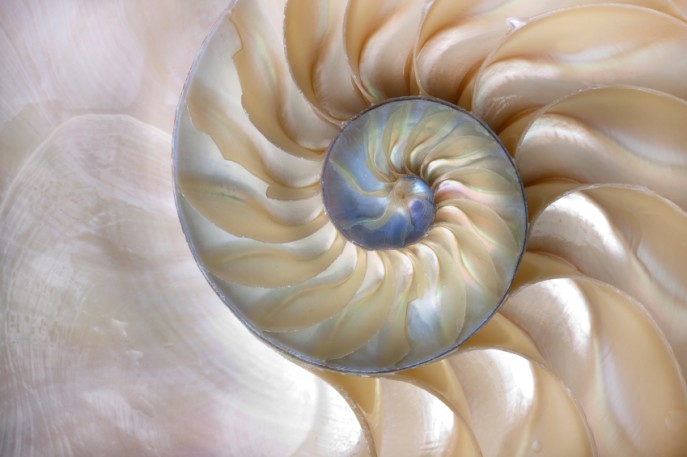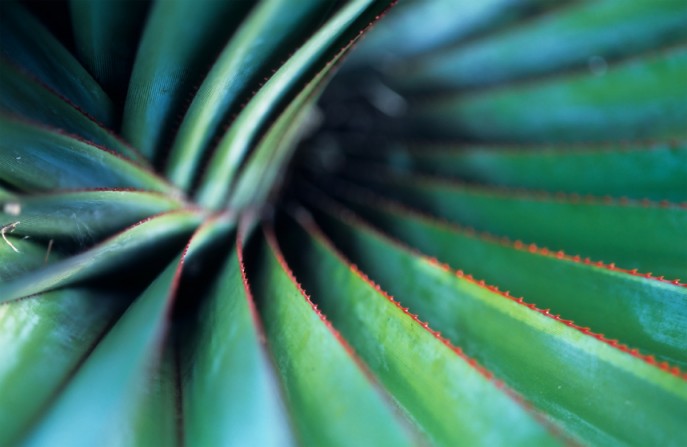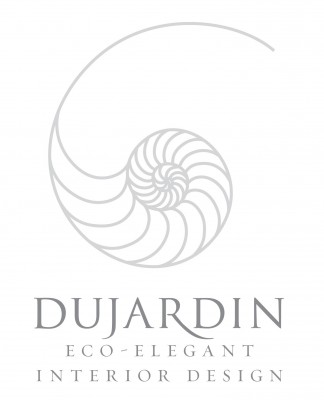
Clients often ask me where I get my inspiration for the colors and textures for the rooms I design. The world outside my door is a constant source of inspiration, especially the sea. (Read an earlier post on my color inspiration here.) I also love to read, and my library is full of beautifully illustrated books that fill my hands and my heart when I can’t be on my beloved Nantucket.
It’s no secret that I have always loved seashells; the logo for my company is a Nautilus shell, a beautiful example of what is called a golden spiral (also known as a logarithmic spiral). Choosing the Nautilus shell was not accidental: it perfectly represents a profession where proportion and balance are key to achieving a pleasing design. We may not need to understand the science behind a masterfully (and mathematically) balanced design, but we are naturally drawn to elegant and balanced compositions, repeatedly found in nature.
 This is a close-up photograph of a spiral palm leaf.
This is a close-up photograph of a spiral palm leaf.
The concept of what makes the proportions of the chambers of a Nautilus shell so beautiful is explained by something called The Fibronacci series, often referred to as nature’s numbering system. It is displayed to perfect effect in the bracts of a pinecone, the heart of a sunflower, the scales of a pineapple, a grain of wheat, a hive of bees, the spiral palm, and even in the proportions of the human body. Leonardo Da Vinci portrayed this concept with his sketch of Vitruvian Man.
Many architects and artists have proportioned their work according to geometric principles known as the golden rectangle, the golden mean and the golden ratio, aesthetically pleasing proportions found over and over again in nature, in stems of plants and veins in leaves, and of course, in seashells such as the Nautilus.
In a golden rectangle, the smaller rectangle is the same shape as the larger rectangle, in other words, their sides are proportional. The curved design of the chambered nautilus shell and the ratios between each of the spirals reveal the fascinating connection between nature, geometry and architecture. Read more here.
Each single shell represents the world of nature’s intricate and mysterious designs, and is a work of art in itself. It is no wonder their shapes are frequently mirrored in our homes and lasting pieces of architecture.
I frequently place shells where they can be seen and admired, especially in beachside homes. In case you’re looking for a little inspiration yourself, here are two seashell books you might find on my coffee table if you were to visit:
The World’s Most Beautiful Seashells won the Coffee Table Book Award of the National Association of Independent Publishers for 1996. Filled with stunning pictures by photographer James H. (Pete) Carmichael, who is especially well-known for his work with shells, butterflies, and rainforests, the wonderfully-written text is by Leonard Hill, a lifetime shell enthusiast, and a biologist employed by the US government who monitors the health of the oceans.
If you’ve ever come home from the beach with a pocket full of seashells, then this book was written just for you! Written by Marlene Hurley Marshall, it’s filled with inspiring ideas of all the wonderful things you can do with your beachy treasures. Frames, chandeliers, boxes, mirrors: they can all be enhanced with memories of your time spent seaside.
“I send thee a shell from the ocean-beach;
But listen thou well, for my shell hath speech.
Hold to thine ear
And plain thou’lt hear
Tales of ships.”





